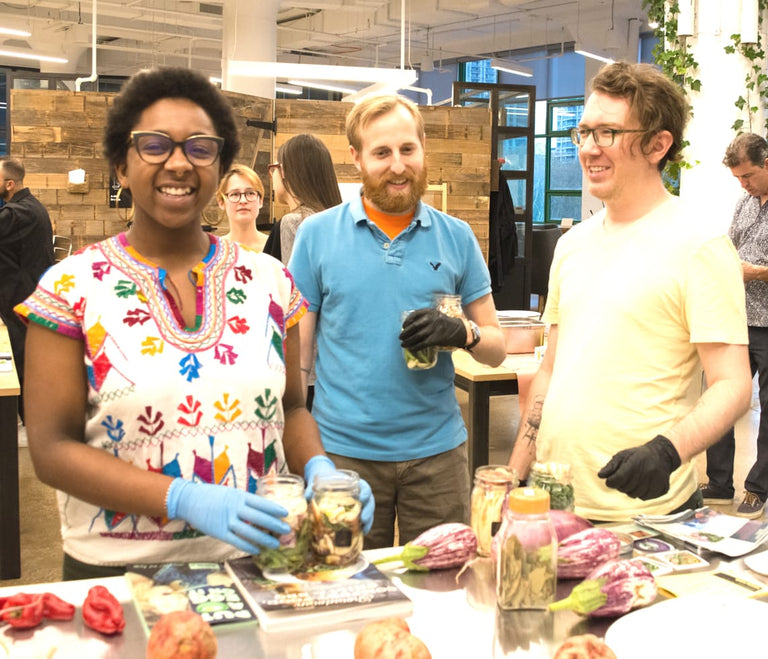How to Organize Your Fridge
By Jessica Kulick, Local Roots subscriber & Food Lover
New year, new you? Maybe, maybe not, but at the very least you can clean up your fridge. Your food will stay fresher for longer, and there won’t be any frightening science experiments (read: moldy stuff) in the way when it’s time to cook and eat. Here’s how:
First things first: take everything out of your refrigerator and clean those drawers and shelves! I like to use Mrs. Meyer’s glass cleaner, but any multipurpose cleaner will do. If one of your New Year’s resolutions is to DIY more often, mix together equal parts white vinegar and water in an empty spray bottle and then spritz and scrub away. Hot tip: vinegar can be a little stinky, so putting a few drops of an essential oil like tea tree or citrus helps negate some of the odor.
Throw away anything that’s expired or beyond recognition as food. That includes dumping any leftovers that are more than four days old.
Now, we organize. Since most of us purchase the same basics in the same packaging week after week, move the interior shelves to fit the products you buy most often.
Once your shelves are in place, start putting things back inside by grouping like items together. Place salad dressings, condiments, and sandwich fixings like pickles and sauerkraut on the fridge door, since all of these items can handle the temperature fluctuations of when you open the door, peek in, and just...look around.

Make sure your dairy doesn’t land on the door shelves. Instead, place milk on the bottom shelf in the back, where it’s coldest, along with yogurt and sour cream. Eggs and cheese belong on the middle shelf, where the temperature is most consistent.
Any raw meat or seafood that is not going to be used within the next 3-5 days should be placed in the freezer, where it can safely stay for up to four months. (This chart from FoodSafety.gov is a handy reference for storage time limits.) Raw meat and seafood you’re planning on using soon should be placed on the bottom shelf, ideally with a tray or plate underneath it to prevent any spills from contaminating the food below.
Fruits and veggies go in the crisper drawers. My soon-to-be mother-in-law taught me the following awesome trick: to keep your greens from wilting quickly, line an airtight container with a sheet or two of dry paper towel. Place your clean, dry greens inside, then place another sheet of paper towel on top before sealing with the lid. You will be amazed at how the paper towels absorb humidity and keep your greens fresher.
A plastic bag stops air from circulating, which leads to produce spoiling faster. So when storing your fresh veggies and fruit in a plastic/compostable bag, make sure there is some air in it to allow your produce to breathe. If you’re intent on keeping things more sustainable, reusable mesh bags are a nice options.
Remember that not everything belongs in the fridge. Produce like onions, potatoes, tomatoes, bananas, and winter squash do best when left on your kitchen counter—though if, for example, your landlord keeps your apartment at Saharan temperatures and you simply must refrigerate, at least let them warm up on the counter before using them. Store bread in a dark cupboard or bread box if you’re planning on using it soon, otherwise, tuck it in the freezer for up to three months. Be sure to pre-slice it so that it’s much easier to eat when you’re ready!
Should butter and coffee be refrigerated? The rule of thumb for butter is if you’re planning on using it within a week’s time, you can leave it in a covered container at room temperature. If not, into the fridge it goes. Ground coffee and whole beans will stay freshest in an opaque, airtight container, away from heat, light, and moisture.
A few final thoughts: a bit of air flow helps to keep your food at its freshest, so try to avoid the temptation of packing your fridge to its absolute fullest (not that you’ll be able to carry all those groceries up a fifth floor walk-up anyway). Pull older foods and fragile produce like greens to the front so that you eat them sooner. Tidy up spills and messes right away, and clean out your fridge at least quarterly. Your roommates, your significant other, and your wallet will thank you.
Rather have a taste first?
Local Roots Experiences are fun, pop-up events where we bring the farm to you!

Become a Harvest Club Pick Up Location
Are you a NY based cafe, bar, or neighborhood business? Become a Harvest Club pick up location and have community members come to your establishment each week to pick up their Local Roots harvest.
Top






